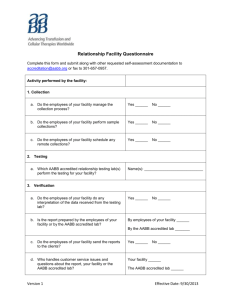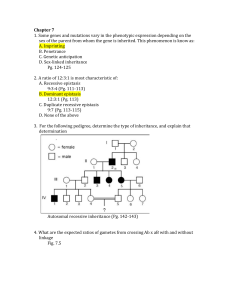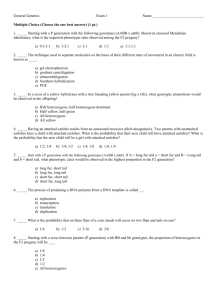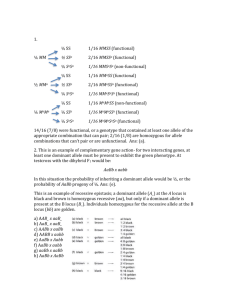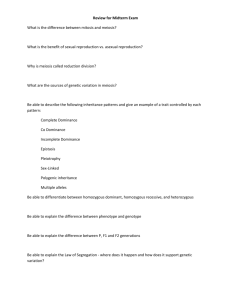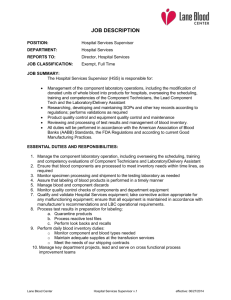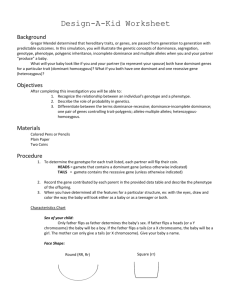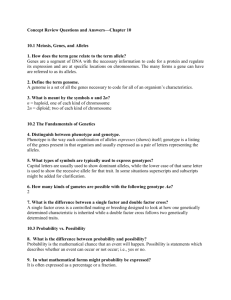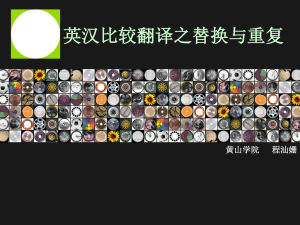Chapter 7
advertisement
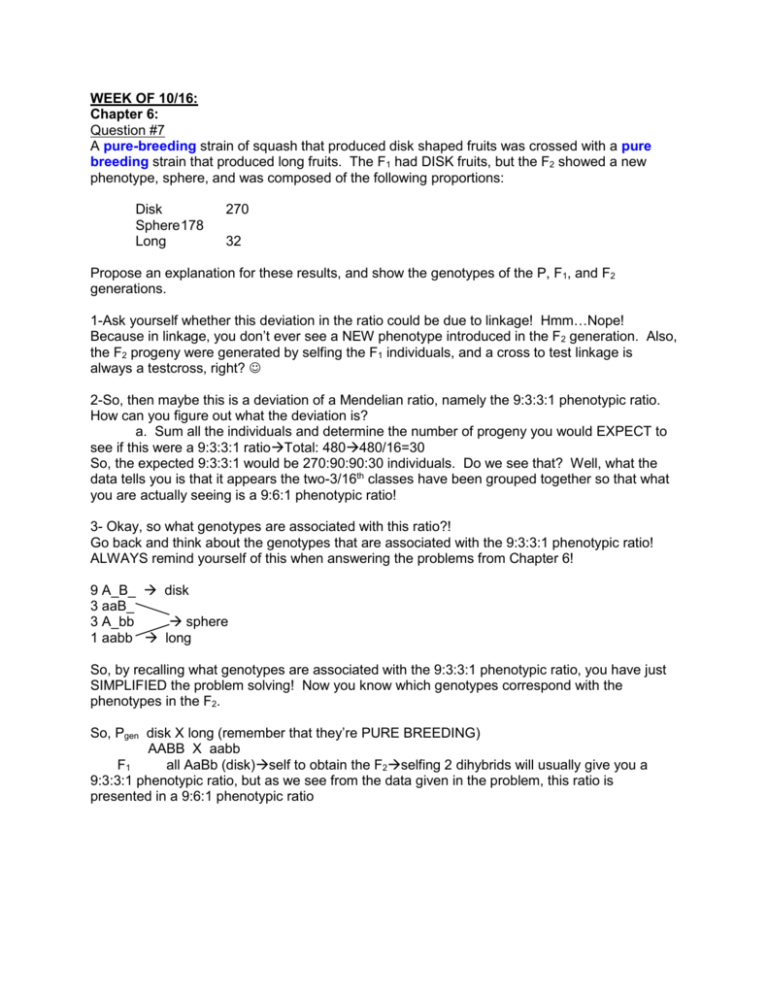
WEEK OF 10/16: Chapter 6: Question #7 A pure-breeding strain of squash that produced disk shaped fruits was crossed with a pure breeding strain that produced long fruits. The F1 had DISK fruits, but the F2 showed a new phenotype, sphere, and was composed of the following proportions: Disk Sphere 178 Long 270 32 Propose an explanation for these results, and show the genotypes of the P, F1, and F2 generations. 1-Ask yourself whether this deviation in the ratio could be due to linkage! Hmm…Nope! Because in linkage, you don’t ever see a NEW phenotype introduced in the F2 generation. Also, the F2 progeny were generated by selfing the F1 individuals, and a cross to test linkage is always a testcross, right? 2-So, then maybe this is a deviation of a Mendelian ratio, namely the 9:3:3:1 phenotypic ratio. How can you figure out what the deviation is? a. Sum all the individuals and determine the number of progeny you would EXPECT to see if this were a 9:3:3:1 ratioTotal: 480480/16=30 So, the expected 9:3:3:1 would be 270:90:90:30 individuals. Do we see that? Well, what the data tells you is that it appears the two-3/16th classes have been grouped together so that what you are actually seeing is a 9:6:1 phenotypic ratio! 3- Okay, so what genotypes are associated with this ratio?! Go back and think about the genotypes that are associated with the 9:3:3:1 phenotypic ratio! ALWAYS remind yourself of this when answering the problems from Chapter 6! 9 A_B_ disk 3 aaB_ 3 A_bb sphere 1 aabb long So, by recalling what genotypes are associated with the 9:3:3:1 phenotypic ratio, you have just SIMPLIFIED the problem solving! Now you know which genotypes correspond with the phenotypes in the F2. So, Pgen disk X long (remember that they’re PURE BREEDING) AABB X aabb F1 all AaBb (disk)self to obtain the F2selfing 2 dihybrids will usually give you a 9:3:3:1 phenotypic ratio, but as we see from the data given in the problem, this ratio is presented in a 9:6:1 phenotypic ratio Chapter 6 (contd.) Question #14: The petals of the plant Collinsia parviflora are normally blue, giving the species its common name “blue-eyed Mary”. Two pure-breeding lines were obtained from color variants found in nature; the first line had pink petals and the second line had white petals. The following crosses were made between pure lines with the results shown: Parents Blue X White Blue X Pink Pink X White F1 Blue Blue Blue F2 101 blue, 33 white 192 blue, 63 pink 272 blue, 121 white, 89 pink a.) Explain these results genetically. Define allele symbols you use and show the genetic constitution of the parents, F1, and F2. This question is generally an extension of Question 7! Look at the data from the first 2 crosses. Blue in the F1 for both of these implies that blue is dominant to BOTH pink and white. Also, notice that the phenotypic ratio in the F2 for both crosses rings bells of a MONOHYBRID phenotypic ratio (where we’re dealing with ONE gene). BUT, now look at the third cross!! Not only are the F1 all BLUE, but the ratio of the F2 does not imply that there is only ONE gene at play here. Here is another case of a deviation of the 9:3:3:1 ratio! So, calculate the EXPECTED number of progeny for each phenotype if this were a 9:3:3:1 270:90:90:30. Now, compare with the data and identify the modified ratio! The data appear to fit a 9:4:3 ratio. Recall the genotypes associated with the 9:3:3:1 phenotypic ratio: 9 A_B_ blue 3 aaB_ pink 3 A_bb 1 aabb white NOTE: It doesn’t matter which of the 3/16th ratios you choose to include in the “4” part of the ratioIt all works out in the end…Try it out! See what happens when you choose to group aaB_ and aabb, then see what happens when you choose to group A_bb and aabb. You’ll see that it doesn’t make a difference. So, now we can go back to each of the crosses and decide what the genotypes of the individuals are (it might also help explain WHY there was the 3:1 ratio) Cross 1—blue X white (PURE BREEDING) Blue = AABB ; white = either AAbb or aabb Pgen AABB X AAbb F1 all AABb (blue) F2 ¾ B_AA (blue) ¼ bbAA (white) OR AABB X aabb all AaBb (all blue) 9:4:3 So, the genotypes of the parents in Cross 1 MUST be AABB X AAbb Cross 2—blue X pink (PURE BREEDING) Pgen AABB X aaBB F1 all AaBB (blue) F2 ¾ A_BB (blue) ¼ aaBB (white) Cross 3—pink X white (PURE BREEDING) Pink = aaBB ; white = either aabb or AAbb Pgen aaBB X aabb OR aaBB X AAbb F1 all aaBb (pink) all AaBb (all blue) F2 ¾ B_aa (pink) 9:4:3 ¼ bbaa (white) So, the genotypes of the parents in Cross 1 MUST be aaBB X AAbb b.) A cross between a certain blue F2 plant and a certain white F2 plant gave the following progeny : 3/8 blue 1/8 pink ½ white What must the genotypes of these 2 F2 plants have been? Since the question does NOT state that the individuals are PURE BREEDING, you cannot assume that they are…So, Blue= AABB or AABb or AaBB or AaBb White = AAbb or Aabb or aabb ▪white will always contribute “bb” If White: If Blue: AA Aa AA all AA all A_ Aa all A_ ¾ A_, ¼ aa REMEMBER! In order to get PINK, there must be “aa” So, we know that the blue individual MUST be Aa and the white individual MUST be Aa in order to get pink progeny… If White: If Blue: bb BB Bb all Bb REMEMBER! In order to get a WHITE, there must be “bb” ¾ B_, ¼ bb So, we know that blue individual MUST be Bb and the white individual can only be bb in order to get white progeny… Put all of this information together!! Blue X White AaBb X Aabb ¾ A_ 3/8 A_Bb (blue) ½ Bb ¼ aa 1/8 aaBb (pink) ¾ A_ 3/8 A_bb (white) ½ bb ½ white ¼ aa 1/8 aabb (white) Chapter 7 Question #9 Describe the Streisinger model for frameshift formation. Show how this model can explain mutational hotspots in the lacI gene of E. coli. DON’T PANIC!! Look up Streisinger in your glossary…It should direct you to page 206 of your text along with pages 210-212. This model describes slipped mispairing!! Pay special attention to Figure 7-9 (it explains HOW the model works to create additions and deletions) and the figures on page 211 (these explain how this mechanism creates addition and deletion mutations in a specific bacterial gene). But this model does not only apply to bacterial genes, right?? Think about some human disorders about which you’ve read and Dr Cann lectured! See pages 213-215 for a description of how slipped mispairing has been proposed as the mechanism for trinucleotide repeat disorders!! Question #14 Describe the repair systems that operate AFTER replication. There’s a very nice table provided in this chapter (Table 7-3, page 220) that tackles the repair systems. There’s also reading about post-replication repair mechanisms on pages 217-219. Question #21 A certain compound that is an analog of the base cytosine can become incorporated into DNA. It normally hydrogen bonds just like cytosine, but it quite often isomerizes to a form that hydrogen bonds LIKE thymine. Do you expect this compound to be mutagenic and, if so, what types of changes might it induce at the DNA level? Remember that a base analog is a chemical whose structure MIMICS that of a DNA base (but it is NOT a proper base). So CG, but if the analog isomerizes and starts bonding LIKE thymine analogA What once had base pairing properties of a C, now has properties of a T. This is what is known as a CGT=A TRANSITION mutation. It’s a transition because C and T are both pyrimidines; a transversion mutation would (in this case) alter CG A=T. In this case, C and A are not the same type of base.
